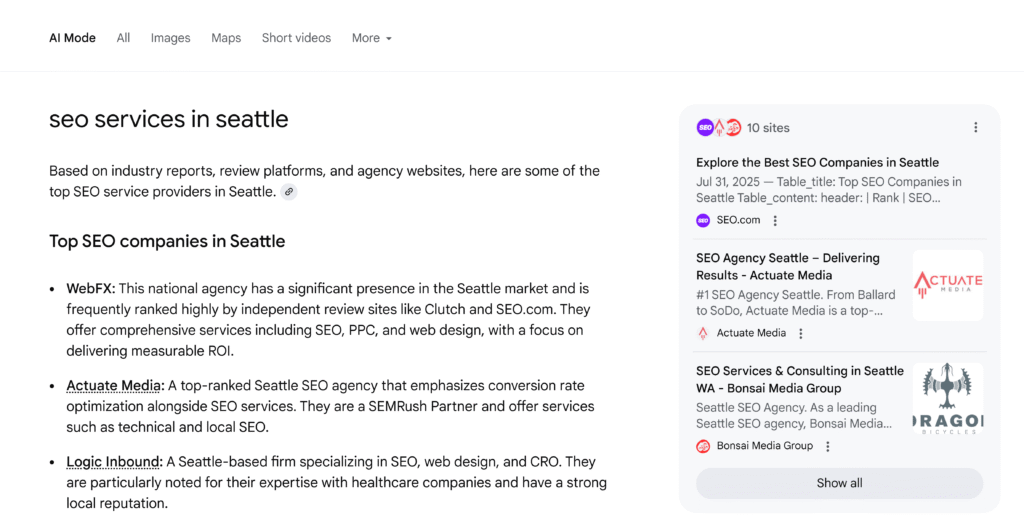When you ask Google or ChatGPT a question, have you ever wondered why certain answers appear first? That’s not luck – it’s Answer Engine Optimization (AEO) at work. As search moves from keywords to questions, AEO is becoming the new frontier for digital visibility. So, what exactly is AEO, and why does it matter more than ever in the AI era?
“Answer engine optimization (AEO) improves a brand’s visibility in AI-powered platforms like ChatGPT, Microsoft Copilot, and Perplexity AI by earning mentions, citations, and placements in conversational responses.”
– SEO.com
Understanding What Is AEO in SEO
How AEO changes search from keywords to questions
Answer Engine Optimization shifts focus from ranking for keywords to getting your content chosen by AI systems to answer user questions directly. Rather than targeting phrases like “best running shoes,” AEO targets complete questions such as “What are the best running shoes for flat feet?”
This shift is happening rapidly. One in ten U.S. internet users now turns to generative AI first when searching online. With ChatGPT serving 400 million weekly users, brands must adapt quickly.
By 2026, experts predict 25% of organic traffic will move to AI chatbots and virtual agents. This isn’t just a trend but a fundamental transformation in information access.
The role of structured data in answer engine optimization
Structured data is the backbone of effective AEO. When you implement schema markup, you’re providing AI systems with a clear roadmap to understand your content’s meaning and context.
For AEO success, organize your content with AI in mind:
- Use clear headings that reflect common questions
- Implement FAQ schema markup
- Create direct answer blocks for specific queries
- Use tables and lists for easy parsing by AI
This structured approach helps AI engines confidently extract and present your information to users seeking answers.
Why AEO matters more for voice and AI-driven searches
Voice searches and AI platforms require a different approach than traditional text searches. When people use voice assistants, they typically phrase queries as complete questions and expect immediate, concise answers.
AEO focuses on structuring content so it gets featured in AI-generated responses, even if users never visit your website. With AI Overviews now appearing in 16% of all Google desktop searches in the United States, your goal isn’t just to rank but to be THE answer that AI systems choose to present.
Key Differences Between AEO and Traditional SEO
Content structure differences in AEO vs SEO
Traditional SEO often focuses on comprehensive, keyword-rich content. While still valuable, AEO demands more structured, direct answers to specific questions.
For effective AEO, your content should:
- Lead with clear, direct answers
- Use concise, factual statements
- Organize information logically
- Include FAQ sections addressing common queries
AEO content puts answers front and center, making it easy for AI to extract key information while still engaging human readers.
How intent targeting varies in AEO and SEO
Traditional SEO targets broader intent categories like informational, navigational, or transactional. AEO requires understanding the specific questions users are asking and how they’re asking them.
This shift demands deeper research into user questions and creating content that directly addresses these specific queries rather than broadly covering topics. It’s about anticipating conversational search patterns and natural language queries that reflect how people actually talk.
Measuring success in AEO versus SEO
Success metrics differ between AEO and traditional SEO. While SEO typically measures keyword rankings, organic traffic, and click-through rates, AEO success involves:
- Featured snippet appearances
- Voice search result inclusion
- AI citation frequency
- Brand mentions in AI responses

For many brands, the goal of AEO isn’t always to drive immediate website traffic but to build brand visibility within AI systems that may not include clickable links in their responses.
Conclusion
Answer Engine Optimization represents the next frontier in digital visibility. While it builds on SEO fundamentals, AEO adapts to a world where AI increasingly mediates information delivery. The most successful digital strategies will blend traditional SEO with forward-thinking AEO approaches. Don’t think of it as replacing SEO but evolving it to thrive in an AI-driven future where being the answer matters as much as being found.
FAQs
What is the main goal of answer engine optimization?
The main goal of AEO is to increase your brand’s visibility within AI-generated responses from systems like ChatGPT, Google AI Overviews, and voice assistants. Unlike traditional SEO that drives website traffic, AEO focuses on getting your content cited when AI systems answer user questions directly.
How does AEO work alongside SEO strategies?
AEO complements rather than replaces SEO. Core SEO principles remain essential for AEO success, including quality content, site authority, and structured data. The key difference is AEO’s focus on question-based optimization and direct answers. Smart marketers integrate both approaches to maximize visibility across all search platforms.
What are the benefits of using AEO in digital marketing?
AEO offers several key advantages: capturing visibility in AI platforms, positioning your brand as an authority, preparing for voice search growth, improving user experience with direct answers, and future-proofing your content strategy as search continues to evolve toward AI-mediated experiences.
Is there any overlap between AEO and SEO practices?
Yes, significant overlap exists. Both strategies value high-quality content, proper site structure, and building authority. The main difference lies in content formatting and success metrics. AEO builds on good SEO while adapting to AI-driven search platforms, meaning many traditional SEO best practices support good AEO performance.
How can I implement AEO if I already have an SEO setup?
Start by researching the specific questions your audience asks, then create or update content to directly answer these questions concisely. Implement FAQ schema markup, structure content with clear question-based headings, and focus on building topical authority through expertise and accuracy. Begin by optimizing your most important pages for both traditional search and answer engines.

Ridam Khare is an SEO strategist with 7+ years of experience specializing in AI-driven content creation. He helps businesses scale high-quality blogs that rank, engage, and convert.



